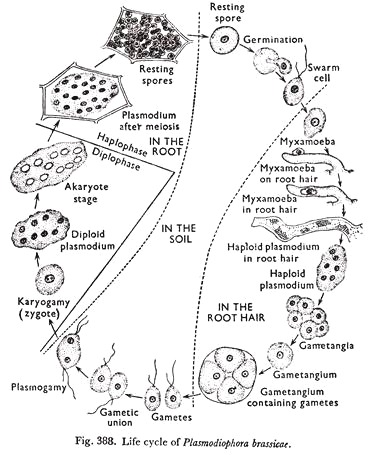Electronic Gating:
Electronic gating and flow cytometry are rapid procedures for enumerating cells.
Among the most commonly used instruments applying the “gating” approach is the Coulter Counter (after the inventor, Wallace Coulter), the main features of which are shown in Figure 2-4.
A glass probe with a tiny aperture near its base is immersed in a sample of cell suspension containing electrolyte (usually a physiological salt solution); the aperture tube is filled with the same electrolyte. Electrical current is caused to flow from a platinum electrode inside the probe through the small aperture to a second electrode submerged in the cell suspension.
At the same time, some of the cell suspension is drawn through the aperture and into the probe by a pump. The passage of a cell through the aperture temporarily alters the flow of electrical current through the aperture, because the cell displaces a volume of the electrolyte and is generally not as conductive as the electrolyte.
The resulting sudden drop in voltage is recorded by the instrument as a pulse (which is displayed on an associated oscilloscope) and is counted by a scaler. A mercury manometer connected to the probe (and therefore also to the pump) operates two switches through two wire electrodes that are inserted through the manometer along its length.
With the pump on and a vacuum applied to the aperture tube, not only is the cell suspension drawn through the aperture but the mercury in one arm of the manometer is also drawn downward below the “start” electrode. When the vacuum is halted (by closing the stopcock), the mercury automatically rises in the arm of the manometer, turning on the scaler as it passes the “start” electrode and turning off the scaler as it passes the “stop” electrode.
With the stopcock closed, the upward movement of mercury in the arm of the manometer draws cell suspension through the aperture, so that the cells present in a volume of suspension precisely equal to the volume of mercury between the “start” and “stop” electrodes are enumerated. Because this volume is known (i.e., the manometer is accurately calibrated), the number of cells present per unit volume of suspension is readily determined. With the electronic cell counter it is possible to count thousands of cells in just a few seconds.
However, if the suspension contains different types of cells, those that are of similar size cannot be distinguished (and separately counted) by this procedure. In such an instance, it may be possible to use chemical methods to eliminate certain types of cells. For example, during a clinical measurement of the white cell count in a blood sample, it is customary to eliminate the red blood cells by adding a few drops of a specific lysing agent to the cell suspension.
The magnitude of each pulse produced by the electronic counter is directly proportional to the size (i.e., volume) of the cell passing through the aperture. The instrument’s two pulse-height threshold controls (upper and lower) may be separately adjusted so that only those pulses whose peak height falls above the lower threshold and below the upper threshold will be counted.
Consequently, for a cell suspension in which cell sizes might vary considerably, one can adjust the thresholds to determine only the number of those cells within a selected size range. By simultaneously increasing both the lower and upper threshold values by the same increment, it is possible to obtain a pulse- height distribution for the sample of cells.
This pulse- height distribution is analogous to a cell-size distribution and is especially useful to cell biologists who are studying the growth characteristics of individual cells, for it reveals for any selected phase of a population growth curve the relative numbers of cells of all sizes (and therefore ages) present in the population. Thus, with an electronic cell-gating instrument it is possible not only to rapidly enumerate the cells in the population but also to obtain measurements of the sizes of the cells. It would be difficult to overstate the value of this instrument to the cell biologist.
Flow Cytometry:
The use of flow cytometry for rapidly counting and analyzing cells was developed by M. J. Fulwyler and L. A. Herzenberg. Typically, the cells to be analyzed are first stained with a fluorescent dye (e.g., ethidium bromide, which combines with the nuclear DNA) or treated with a fluorescent antibody that binds to proteins in the cell surface. The cell suspension is then pumped through a small orifice and into the center of a narrow, horizontal channel in the “flow cell assembly” (Fig. 2-5).
Pumped into the same channel through a second small opening at one end is “sheath fluid,” which serves to sweep the cell suspension away from the measuring orifice and out of the flow cell assembly through a third opening. A beam of light from a laser is directed at the measuring orifice where it excites the fluorescent material in each emerging cell causing the cell to emit a flash of fluorescent light.
The fluorescence is detected by a system of photomultiplier tubes that relay electrical signals to the instrument’s analyzing system. The number of fluorescent light pulses detected by the photomultiplier tubes is directly related to the number of cells passing the measuring orifice.
Moreover, the magnitude of each pulse varies in proportion to the quantity of fluorescent material associated with each cell, and this provides still another measurement parameter. For example, if the fluorescent pulses are produced by the cell’s DNA, then not only are the cells counted, but a measurement is also made of each cell’s DNA content. Thus, one can readily follow the changes that take place in the amount of DNA per cell during the cell cycle. Using flow cytometry, thousands of cells can be enumerated and also analyzed in just a few minutes.

